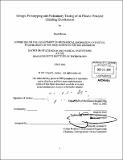Design, prototyping and preliminary testing of an elastic-powered climbing exoskeleton
Author(s)
Briner, Hazel (Hazel Linn)
DownloadFull printable version (2.250Mb)
Other Contributors
Massachusetts Institute of Technology. Dept. of Mechanical Engineering.
Advisor
Hugh M. Herr.
Terms of use
Metadata
Show full item recordAbstract
Human powered elastic mechanisms can be used to reduce work requirements of muscles, by storing and releasing energy to more evenly distribute work load. An exoskeleton was designed to delay human fatigue during rock climbing. This exoskeleton stores energy in the less intensive motion, extension while reaching upwards, and uses the stored energy in the more intensive motion, flexion during upwards ascent. A cuff 3D which will be printed by Objet Geometries Inc. utilizes Arthur Iberall's lines of non-extension to simultaneously maximize rigidity and comfort. Due to the inability of Objet's printed items to withstand the required high forces, a prototype climbing exoskeleton for the arm was fabricated from heat moldable plastic and latex springs. Pilot tests were conducted with the prototype and preliminary results were promising.
Description
Thesis (S.B.)--Massachusetts Institute of Technology, Dept. of Mechanical Engineering, 2011. Cataloged from PDF version of thesis. Includes bibliographical references (p. 24).
Date issued
2011Department
Massachusetts Institute of Technology. Department of Mechanical EngineeringPublisher
Massachusetts Institute of Technology
Keywords
Mechanical Engineering.